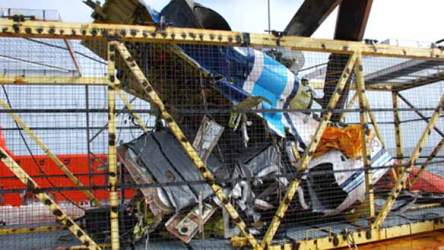Canadian safety investigators say the Cougar Helicopters S-92 that went down in the Atlantic Ocean off the coast of Newfoundland on 12 March hit the water “belly first” in an upright position with a “tail-low” attitude, a finding that could indicate the pilots may have been able to maintain attitude control of the twin-engine heavy helicopter if not its vertical descent rate during the ditching attempt.
Investigators said accelerometers in the seats of the helicopter showed an impact force of 20Gs, a level one expert called “quite abrupt.” The aircraft’s tail section separated from the main fuselage, with the upper deck and main cabin badly damaged but holding together. Seventeen of the 18 onboard perished in the crash. The picture below, provided by the Transportation Safety Board of Canada (TSB), shows the top deck during the recovery process.
 ©TSB
©TSB
TSB officials during the most recent press conference on 26 March say power to the flight data and cockpit voice recorders was cut off for unknown reasons as the helicopter attempted to cruise back to land at 243m (800ft) altitude. Shortly before, pilots reported the loss of all oil pressure in the helicopter’s main gearbox (MGB), the mechanism that transfers power from the twin General Electric CT7-8A turboshaft engines to the main rotor and tail rotor.
That same oil also cools the aircraft’s two electrical power generators, raising the possibility that aircraft power was lost before the crash. Backup power is supplied by a Honeywell auxiliary power unit, providing it is started.
Less than one minute after the recorders stopped, pilots radioed that they were preparing to ditch. Radar returns showed the aircraft descend to approximately 91m at a rate of approximately 1,000fpm before disappearing.
Officials say they are confident that the in-flight oil loss was caused by cracking of two of the three titanium MGB oil filter bowl studs, a finding that prompted US and European regulators to ground the fleet on 24 March. Sikorsky in January asked operators to replace the studs with steel equivalents after a similar failure last year, though the alert gave operators one year or 1,250h to perform the work.
Canadian investigators are unsure as yet if the crew had attempted to deploy the helicopter’s three flotation devices during the ditching. The forward float was found to be out of its bag while the two rear floats remained in their bags.
Commenting on the possibility that the loss of MGB oil may have caused the main rotor to seize, TSB officials say damage signs on the rotor heads and rotor blades indicate there was “some” rotor energy apparent at splashdown. However they were not yet able to determine whether the rotation was the result of engine power or air pressure from an autorotation attempt.
Investigators are hoping retrieved memory cards from the helicopter’s Rockwell Collins avionics suite might help uncover aircraft performance data during the final seconds of the flight. The lone survivor in the accident has been released from the hospital, but has not yet commented on the crash.
Source: FlightGlobal.com



















